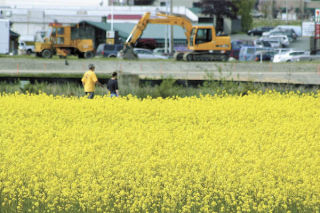Yellow plant thrives in town
Oak Harbor is a spicier place to live with a little mustard on it.
For the past few weeks blooming wild mustard has splashed the lower environs of the city with a swath of yellow, spanning a couple of acres in the Freund Marsh area.
Those walking the city’s Waterfront Trail between Windjammer Park and Scenic Heights Road hike past several hundred yards of the bright yellow weed.
The Freund family didn’t plant the mustard, it just started growing there.
Wild mustard is nothing unusual on Whidbey Island. Drivers on Highway 20 will first start noticing it in bunches as they round the curve at Penn Cove in the San de Fuca area. But for sheer quantity and yellow abundance, nothing matches Oak Harbor’s display.
It’s one of those common plants that few people spend much time thinking about, but at least one islander has a fondness for it.
“It’s pretty. I really like it,” said Toni Grove, a herbal scientist living in Langley who just became a WSU Master Gardener. She offered some words of wisdom for islanders, only slightly tongue-in-cheek: “Eat your mustard, it’s good for you.”
Mustard greens contain important vitamins, mustard can be used as a poultice to draw blood to an injured area, and it’s a great condiment on hot dogs.
Grove and Tim Miller, WSU Extension weed specialist in Mount Vernon, agree that the type of mustard most prevalent on Whidbey Island is called birdsrape mustard (Brassica campestris), part of the rapeseed family. It’s the basic plant used to make canola oil sold in supermarkets, which is a contrived name. “They didn’t want to market rapeseed oil,” Miller explained.
Miller said some farmers grow mustard as a cover crop. That could be how it became so prevalent on North Whidbey. When it’s chopped up and plowed into the soil it acts as a natural fumigant, killing soil-borned diseases. On the negative side, it will interfere with other crops, and even cross-pollinate with cabbage which, on Whidbey, is a money crop.
There are many varieties of mustard growing on the island, including Jim Hill, hedge mustard, those generally described as black, brown and yellow. To make mustard as a condiment, the basic idea is to take the seeds when the pods are ripe in late summer, crack them open, grind them into powder, and mix with flour and vinegar into a paste.
If you try it with Oak Harbor’s mustard, the results will be eye-opening. “Birdsrape is hot. It’s got more ooomph to it, like Chinese mustard,” Hill said. “It clears your sinuses out.”
Chamber of commerce types might see Oak Harbor’s acres of yellow as a marketing opportunity. How about the Oak Harbor Wild Mustard Festival?
The idea isn’t entirely original, according to Stacy Neumiller, Island County Master Gardener program coordinator. She hails from Napa, Calif., where they use mustard as a cover crop in the vineyards and every year hold the Napa Mustard Festival.
“It’s a sign of spring, and a celebration of the mustard,” Neumiller said. “But it could be a Whidbey Island festival. It’s not used here much, but it just grows everywhere.”



